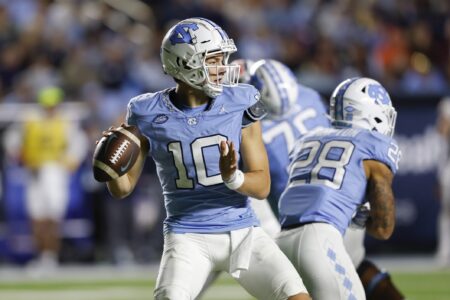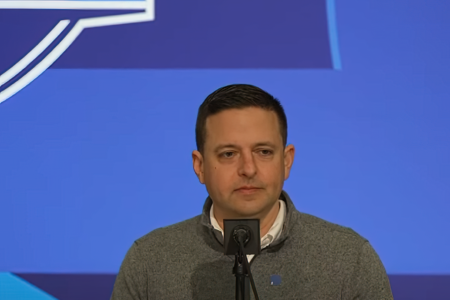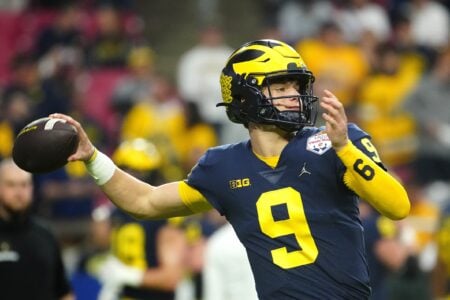Brady-To-Branch
Third String But Playing on Special Teams
- Joined
- May 3, 2006
- Messages
- 732
- Reaction score
- 2
http://insider.espn.go.com/nfl/preview05/columns/story?columnist=joyner_kc&id=2148654&num=0
Much has been written about the Patriots' defensive scheme. Most of it revolves around the genius of the play calling, but there is something very specific in the scheme's design that makes it special.
The key to the Patriots' defense is the way they use their linebackers. It is worth noting that Bill Belichick was a linebackers coach for years before becoming a head coach. In fact, Belichick was present at the creation of the modern-day 3-4 rush linebacker.
Belichick's first year as linebackers coach for the New York Giants coincided with the arrival of Lawrence Taylor, a weak-side outside linebacker. In the 3-4 scheme, these linebackers either rush the passer or drop into coverage, but Taylor was such a dominant pass-rusher that he changed the way the league viewed the position. This started the evolution of the 3-4 rush linebacker that has continued to this day.
The first step in the evolution came when teams began moving the rush linebacker around the field. In the 1970s, the Dolphins actually employed the strategy with linebackers such as Bob Matheson. But Taylor and LT copycats were such game breakers that defensive coordinators moved them around with much greater frequency. This gave those coaches a whole new array of strategic and tactical options.
The next phase in the evolution came courtesy of **** LeBeau, the defensive backs coach for the Pittsburgh Steelers under Dom Capers in the early 1990s. The Steelers had a very athletic set of linebackers with Greg Lloyd, Chad Brown and Kevin Greene, and LeBeau realized the team didn't need to restrict the rush-linebacker role to a single player. Instead, Pittsburgh could rush either or both outside linebackers, or drop them into coverage, on any given play. This increased the variety of options dramatically, but LeBeau wasn't finished.
Pittsburgh also had athletic defensive linemen, such as Kenny Davidson and Joel Steed. LeBeau realized he could use those guys the same way he used the linebackers -- either rushing them or dropping them into coverage on any given down. LeBeau even used this technique with his nose tackles, reasoning that since the middle short zones of the field aren't that hard to protect, he could drop Steed, his relatively rangy nose tackle, into that area. This also allowed him the option of rushing or dropping his inside linebackers as well. The defense gained a lot of pass-rushing versatility without losing much in coverage ability.
LeBeau's real genius wasn't simply in dropping defensive linemen into coverage. Taking a broader view, his "zone blitzing" was the first major step in removing some of the artificial limitations placed on defensive players by their static positional assignments. In a standard 4-3 defense, a team's front seven players basically were locked into their positions and responsibilities. LeBeau's 3-4 zone blitz scheme allowed defensive linemen to do so much more.
Belichick's 3-4 scheme is the next step in this evolution. The Steelers' 3-4 zone blitz was defensive-line oriented and redefined what defensive linemen could do. The Patriots' 3-4 scheme is linebacker-oriented and is similarly breaking the mold for linebackers.
Belichick recognized two problems with a defensive-line oriented zone blitz scheme. First, even though you can drop the nose tackle into the short zone, it's not likely he'll be agile enough at 300 or so pounds to be adept in coverage. Second, to run the scheme properly, a team must find very athletic defensive ends who not only can play the run and rush the passer but also can drop into coverage. Such players are rare.
The Patriots' solution to the first problem was fairly simple. Instead of dropping oversized nose tackles into coverage, they opted to give that assignment to the 3-4 inside linebacker. Known as "pluggers," these are bigger linebackers whose main purpose is to stuff the run, but they can defend the pass better than nose tackles. On passing downs, about the only time they'd need a nose tackle to drop into coverage, the Patriots replace the lineman with a plugger linebacker lined up as a nose tackle. If the opponent runs the ball, the plugger is big enough to help stop it. If the opponent passes, he's much better equipped to drop back.
New England's solution to the second problem was, in hindsight, fairly obvious, but it didn't seem so at the time. In 1996, New England drafted defensive lineman Tedy Bruschi out of Arizona. At 250 pounds, Bruschi was a bit small to play defensive end and was struggling, so Belichick and his staff decided to teach Bruschi to play linebacker. His success as a rush linebacker in the 3-4 zone blitz scheme led to an epiphany of sorts. The Patriots realized they could draft undersized defensive linemen and convert them into linebackers. In doing so, they oriented their zone blitz scheme around linebackers rather than defensive linemen. This subtle and seemingly small change had several advantages.
First, it gave the Pats the ability to run the 3-4 rush linebacker concept up and down the line. Instead of having rush linebacker specialists alternating with defensive linemen, which could help an opponent read the defense, the Patriots fielded an entire set of linebackers who could either rush or drop into coverage. This allowed New England to vary the composition of its front seven to anything from a 2-5 -- two linemen and five linebackers -- to a 1-6 or even 0-7, alignments that hadn't been seen before. Even analyst John Madden said he hadn't seen a 1-6 or 0-7 alignment in all of his years covering the NFL.
The flexibility gave the Patriots a huge strategic advantage by making it increasingly difficult for opposing offenses to figure out their defensive personnel sets. Instead of being able to key on a rush linebacker and a plugger linebacker, or a linebacker and a down lineman, offenses now had to key on multiple, flexible lineups on every play. Opponents couldn't determine whether the Patriots were playing for the run or the pass.
And because their linebackers were so versatile, the Patriots didn't need to carry as many defensive linemen on the roster. Instead, they replaced those defensive line roster spots with linebackers. This allowed New England to stock up on players at a position the Pats' coaching staff specialized in teaching and helped them in acquiring personnel. Since they were looking for a certain type of linebacker, their talent pool was larger than that of other teams, and included college defensive linemen and any undersized defensive lineman struggling to hang on with another NFL team.
This system also gave them a much greater ability to absorb injuries to their defensive front seven. A typical 4-3 team usually will have one or two utility backup players. If that team suffers an injury to the starter and one of the backups, it will be down to a third-stringer. Since almost the entire Patriots linebacker corps is composed of fluid -- as opposed to static -- players, they are able to move up and down the line and fill in where necessary. That flexibility and versatility is how New England absorbed a rash of defensive injuries in 2003.
Because the Pats have so many players who can fill in, they also can use roster spots to provide depth on players who fill a very specific role. A few good examples of this would be Ted Washington, Keith Traylor and Roman Phifer. All are good against the run but not so good against the pass. But they were a luxury New England could afford the past few years.
Observers call Belichick a football scientist, but I think a more appropriate term would be football intellectual. A scientist performs studies and analyses, trying to expand the knowledge of a particular subject. An intellectual sees things on a higher plane and is able to assimilate ideas in ways others can't.
Belichick and his staff took a position, linebacker, that already had one of the most flexible job descriptions and broke its mold. Their success emboldened them to assign flexible roles to so many other positions. It all seems so simple, yet the benefits are tremendous and far-reaching. This has as much to do with the Patriots' success as their efficient salary cap management, and it's amazing no other team has even come close to mimicking it.
KC Joyner, aka The Football Scientist, has a Web site at http://thefootballscientist.com. He is a regular contributor to ESPN Insider.

















